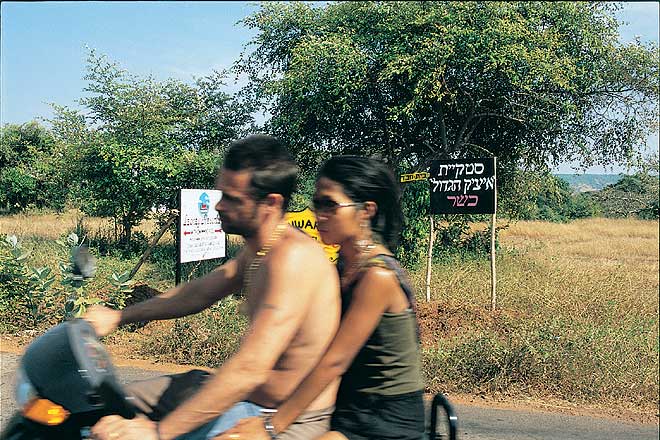I almost got lost getting to Curlies shack, slung low on a tip of Anjuna beach. True
Finally staggered into Curlies, where the old heads gather, and I see they’re already hopelessly outnumbered. Idealistic tie-dyed hippie internationalism is fading away, and organised enclaves are springing up as replacement. Rather than peddling homemade hash-brownies and mismatched sandals and living under the coconut trees, long-staying foreigners are plunging into business, raising families, and bringing over their friends to live next door.

Demand is rising at a dizzying pace, another four domestic airlines have commenced flights to Goa and direct charters ferry in hundreds of thousands of foreign visitors from more than a dozen countries. At any given point in the peak of high season this year (the fortnights that bookend New Year), it’s expected that there will be 10,000 Russians in Goa, more than 20,000 Israelis and a similar number of Brits, the numbers just keep going up.
It’s 9 o’clock at the Baba Yaga restaurant in moonlit Chapora, where the neat little rooftop is a main hangout for Russians in Goa. Folksy drawings of the fairy-tale witch cover the parapet, I’m elbow-deep into bowls of hearty kasha (buckwheat) and limpid pelmenyi (dumplings) and soothing Ukranian borscht, mellow Russian dub music from the St Petersburg underground scene fills the air, and Lenin scowls down disapprovingly from above the bar. When the bill comes, it’s scribbled in Cyrillic.
The Russians at the table agree, Goa is where they want to be, and three out of the five present want to move permanently to the beach that lies just north. One of them tells me, “for 50 years, Russians only had one beach abroad, Brighton Beach in Brooklyn.”
The mainstream long-staying phenomenon took off with the British, after the initial boom of charter tourists in the 1990s. Lots of working-class couples roamed around on two-week packages, and realised that they could live very comfortably for peanuts, that a nice condo in Candolim cost less than a closet in the Costa del Sol. They exercised loopholes in the law, hundreds of retiree couples bought property, and an expatriate community began to coalesce, complete with pubs and restaurants. There’s even a ruddy-faced British butcher sellingbangers and hearty pork pies.
Soon, younger visitors became attracted to the laid-back lifestyle and rapidly increasing tourism potential. In the last three years, Goa has seen a huge wave of young entrepreneurial long-staying foreigners, they’re opening restaurants and nightclubs, performing therapies and playing music, they’re bringing up their children in India and have no intention of ever leaving.

Beth Spaul, an energetic 28-year old from Essex, isn’t planning on going back to England to have the baby she’s pregnant with. She plotted her move to Goa for a full nine years, after meeting her (British) future husband while holidaying at a nearby beach, then finally managed to shift in 2004. “I wouldn’t have ever wanted to have a baby in India, let alone Goa,” she tells me, “but things have changed so much, and there’s even a wonderful German-run natural birthing centre nearby, why bother with going back?”
As Spaul speaks, a knot of fair-haired children rushes past to the back of the house. On arrival in Goa, she’s started a school for the children of long-staying foreigners, and the Yellow House Pre-School now employs three full-time British teachers and caters to 33 children. It’s the most expensive school in Goa (7,000 rupees per month), and demand stays very high as more and more foreign children are brought up under the Indian sun.
Further up north, Arambol beach is already laden with thousands of travellers even in early November. This is where forest meets lake, with sand dunes just beyond; it’s a near-mythical dream beach on the hippie trail, where the last Goa Freaks are rumoured to live naked under the stars (they do). But just like Anjuna, the once-remote outpost is now overrun by a different generation, an Israeli crowd has swept in and taken over.
Many of the newcomers are like Ilan Dascal, a computer programmer who set off for Arambol sight-unseen justbefore the monsoon this year. He’s no aimless wanderer, he arrived with a detailed action plan and executed it immediately after entering into partnership with a Goan family. Well in time for this high season, he’s opened up the brightly lit and spotlessly clean Lamuella Guest House and Café.
The name comes from one of the Douglas Adams Hitchhiker’s Guide to the Galaxy books. In the novel, the final volume of that famous ‘trilogy in five parts’, Lamuella is a kind of backwater planet, a place Dascal describes as “a lot like Earth, but just a little, little, bit better.”
Sitting on a sofa in the café’s outside lounge, with meditative music playing, cool green tea in hand, and attractive children playing on the stairs, I can see the point. There’s a laid-back, tolerant and inclusive vibe to everything, an openness that’s hard to beat anywhere in the world. Peaceful, wildly cosmopolitan, eccentric and hard-edged in places, full of surprises, polyglot and multiracial, this is Planet Goa.
places to visit in Goa
tourist places in Goa
Leave a Reply
You must be logged in to post a comment.


